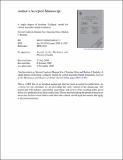A single degree of freedom ‘lollipop’ model for carbon nanotube bundle formation
Author(s)
Cranford, Steven; Yao, Haimin; Ortiz, Christine; Buehler, Markus J
DownloadBuehler_A single degree.pdf (2.103Mb)
PUBLISHER_CC
Publisher with Creative Commons License
Creative Commons Attribution
Terms of use
Metadata
Show full item recordAbstract
Current carbon nanotube (CNT) synthesis methods include the production of ordered, free-standing vertically aligned arrays, the properties of which are partially governed by interactions between adjacent tubes. Using material parameters determined by atomistic methods, here we represent individual CNTs by a simple single degree of freedom ‘lollipop’ model to investigate the formation, mechanics, and self-organization of CNT bundles driven by weak van der Waals interactions. The computationally efficient simple single degree of freedom model enables us to study arrays consisting of hundreds of thousands of nanotubes. The effects of nanotube parameters such as aspect ratio, bending stiffness, and surface energy, on formation and bundle size, as well as the intentional manipulation of bundle pattern formation, are investigated. We report studies with both single wall carbon nanotubes (SWCNTs) and double wall carbon nanotubes (DWCNTs) with varying aspect ratios (that is, varying height). We calculate the local density distributions of the nanotube bundles and show that there exists a maximum attainable bundle density regardless of an increase in surface energy for nanotubes with given spacing and stiffness. In addition to applications to CNTs, our model can also be applied to other types of nanotube arrays (e.g. protein nanotubes, polymer nanofilaments).
Date issued
2009-11Department
Massachusetts Institute of Technology. Department of Civil and Environmental Engineering; Massachusetts Institute of Technology. Department of Materials Science and Engineering; Massachusetts Institute of Technology. Laboratory for Atomistic and Molecular MechanicsJournal
Journal of the Mechanics and Physics of Solids
Publisher
Elsevier
Citation
Cranford, Steven, Haimin Yao, Christine Ortiz, and Markus J. Buehler. “A Single Degree of Freedom ‘lollipop’ Model for Carbon Nanotube Bundle Formation.” Journal of the Mechanics and Physics of Solids 58, no. 3 (March 2010): 409–427.
Version: Author's final manuscript
ISSN
00225096